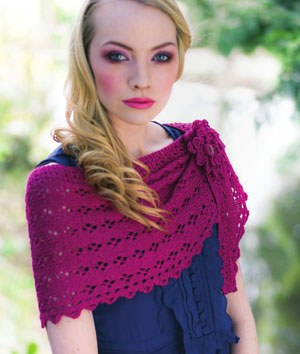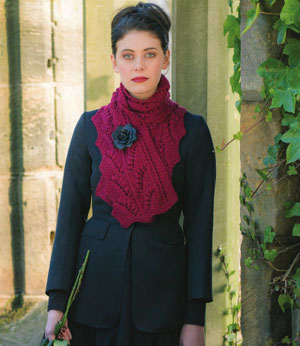In her latest book, the designer and yarn maven’s vintage-inspired style appeals to every woman’s inner girl.
By Christina Behnke With its unabashed femininity and decidedly British modern-vintage aesthetic, Louisa Harding’s Knits from an English Rose, Harding’s eighth book—and that’s not including the countless pattern collections she’s designed for her line of yarns— feels like an arrival. Associate Editor Christina Behnke spoke to Harding about life as a knitwear designer-yarn developer-art director and what it really means to be an English Rose.
With its unabashed femininity and decidedly British modern-vintage aesthetic, Louisa Harding’s Knits from an English Rose, Harding’s eighth book—and that’s not including the countless pattern collections she’s designed for her line of yarns— feels like an arrival. Associate Editor Christina Behnke spoke to Harding about life as a knitwear designer-yarn developer-art director and what it really means to be an English Rose.
What is a typical working day like for you?
Being a knitwear designer is cyclical, and I work in seasons: Spring/Summer and Fall/Winter. Every week I am working on different tasks. At the moment [February 2014] I am designing for Fall/Winter 2014-15, knitting swatches and writing patterns and sending these to my test knitters. In a few weeks, I have photography scheduled. This will involve finishing off the garments, sewing on buttons, sourcing the styling clothes, booking models and choosing locations.
I also attend the yarn shows in Italy twice a year to meet with yarn manufacturers and select yarns for the coming seasons. [I also travel to] present my collections to buyers at trade shows and give workshops all over the UK and US. I am very lucky that every day, I am working on a different aspect of the job.
You work with your husband, photographer Stephen Jessup, to style and shoot your distinctive photos. How does your collaboration work?
The best thing about working with Steve is having someone to bounce ideas around with. We challenge each other and never settle for the first easy solution. Stephen has always had a very definite idea of the “Louisa Harding” visuals, his ideal being that a knitter’s partner will look at the images in our publications and see them as beautiful first and [as] a knitting pattern second.
As a designer who also has a yarn collection, how does inspiration strike?
When I travel to the Italian yarn show Pitti Filatti and see the latest yarns, it is there that I begin to get excited about yarn. I look at the fiber blends, drape and pattern, and I choose yarns that reflect fashion trends or that can challenge me as a designer. It can be about three to four months in the pipeline before I start designing with each new yarn. In the meantime, I am researching the inspiration point for the coming season.
Having studied Textiles for Fashion [at college], I was taught the importance of inspiration. As an example, the Spring/Summer 2014 collection is inspired by the night sky and constellations. This helps with my yarn choices, garment design and photography styling. The whole process seems to be very organic, a sum of all the parts coming together as a whole.
Glitter and embellishment are an important part of your aesthetic. How has this come into play as you’ve developed your yarn collection?
When I was asked to launch my yarn line and publications, I was very aware that with my background at Rowan and Jaeger Handknits, I had to create my own brand identity. I looked to the women in my life as inspiration. From the yarns I choose to the garments I design, everything is very feminine, from the colors to the fit. I also think that, as girls, we all like to embrace our inner Barbie with a little bit of sparkle every now and then!
How do you go about creating color palettes?
At Pitti Filatti, one room of the show is dedicated to color and fashion trends. I take onboard the industry’s suggestions but ultimately choose my own palette based on the season’s inspiration theme, the yarn and how it reacts to dye, and how certain shades react with women’s skin tones. [For example], the fashion trend may suggest a harsh yellow, but this is a very difficult shade to wear. A soft pink or raspberry is much more flattering.
In your introduction to Knits from an English Rose, you describe how the designs are a visualization of the “English Rose”: A girl “whose prettiness is considered to be quintessentially English.” What does “quintessentially English” mean to you
 For me, “quintessentially English” means a girl (we are all still 18 in our heads!) who is happy from the inside, [so] her prettiness is natural. In my world she has a creative spirit and is spirited in her outlook, wide eyed and questioning, inquisitive and ready to learn new things.
For me, “quintessentially English” means a girl (we are all still 18 in our heads!) who is happy from the inside, [so] her prettiness is natural. In my world she has a creative spirit and is spirited in her outlook, wide eyed and questioning, inquisitive and ready to learn new things.
There’s a Victorian vibe to Knits from an English Rose, and I could see many of these designs fitting in on Carnaby Street in the 1960’s as well. Yet all the designs are thoroughly modern. As someone who’s influenced by vintage style, how have you worked throughout your career to develop your own style from many different elements?
I am indebted to the many hours that I spent as a teenager in the Fashion and Dress galleries at the V&A and London Museum. It was here that I absorbed couture techniques and the ethos of handmade clothes, spending hours drawing in my sketch books the details that transformed these pieces into practical and beautiful works of art, from the placement of a button to the embroidery on a collar.
Details have always been important to me, and this most important element, I think, has helped me really identify my own style. If a knitter is going to take the time to make a piece of mine, then it is my duty to ensure that every detail is considered, from the written pattern [and] book layout [to the] garment design and photography.
